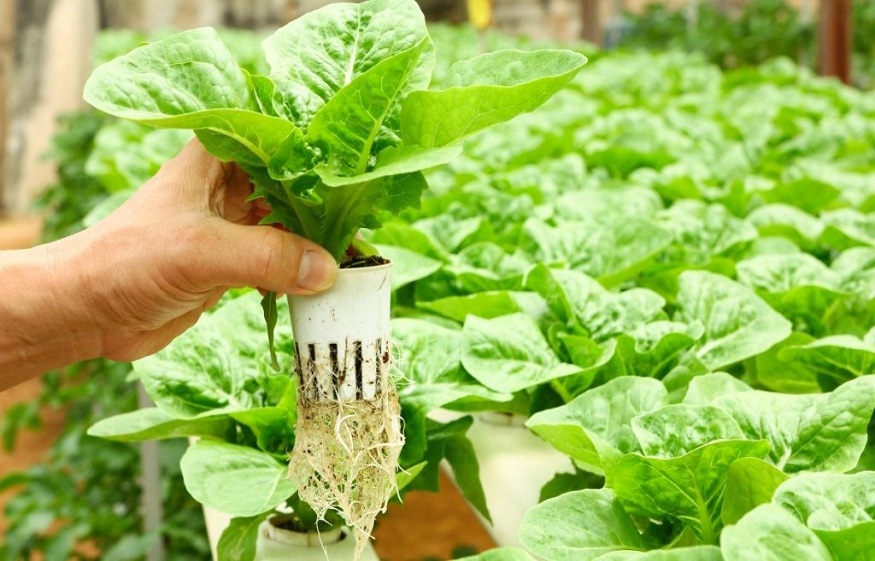Farming has always been an essential part of human life. However, traditional farming methods face many challenges, such as water shortages, soil degradation, and climate change. Hydroponic farming has emerged as an innovative and sustainable solution in recent years.
Hydroponics allows plants to grow in water enriched with nutrients without needing soil. This method increases crop yields and helps save resources, making it an ideal choice for modern farming.
Let’s explore how hydroponics is transforming agriculture and shaping a sustainable future.
What is Hydroponic Farming?
This farming is a way of growing plants using a nutrient-filled water solution in place of soil. The plants directly absorb all the essential nutrients from the water, ensuring faster and healthier growth. This farming technique is performed in controlled environments like greenhouses or indoor setups, where factors such as light, temperature, and humidity can be adjusted to create optimal conditions for plant growth.
Benefits of Hydroponic Farming
1. Higher Crop Yields
One of the biggest advantages of hydroponic farming is its ability to produce more food in less space. Since plants receive the right nutrients and water, they grow faster and healthier. Hydroponic systems allow farmers to cultivate more crops in a smaller area, making it a great option for places with limited farmland. This can help address food shortages and ensure a steady fresh produce supply.
2. Saves water
Water is a precious resource, especially in India, where many regions face water shortages. Traditional farming uses much water, which is lost due to evaporation or inefficient irrigation. Hydroponics, however, uses up to 90% less water because the system recycles and reuses the water. This makes hydroponic farming an environmentally friendly and sustainable option.
3. No Soil Required
Many areas have poor soil quality, making it difficult to grow crops. With hydroponics, soil is not needed at all. Instead, plants grow in water infused with essential nutrients. This eliminates problems such as soil erosion, nutrient depletion, and contamination. It also means that hydroponic farming can be practised in urban areas, on rooftops, or even indoors.
4. Fewer Pests and Diseases
Traditional farming is often affected by soil-borne diseases and pests, leading to crop losses and the need for chemical pesticides. Since hydroponic farming does not use soil, these problems are less likely to occur. This leads to healthier plants and minimises harmful chemicals, making the food safer.
5. Grows Crops All Year Round
One of the biggest challenges in traditional farming is the dependence on seasons. Certain crops can only be grown at specific times of the year. However, hydroponic farming is done in controlled environments, allowing farmers to grow crops throughout the year.
6. Uses Less Space
Hydroponic farming is ideal for urban areas where space is limited. With vertical farming techniques, multiple layers of crops can be grown in a small area. This allows setting up city farms, reducing the need to transport food over long distances. Locally grown food is fresher, healthier, and has a lower carbon footprint.
7. Better Nutrient Control
In traditional farming, plants extract nutrients from the soil, but the nutrient content of the soil varies from place to place. In hydroponics, nutrients are directly added to the water in precise amounts. This ensures that plants get what they need, leading to better growth and higher nutritional value in crops.
8. Less Dependence on Chemical Fertilisers and Pesticides
As hydroponic farming eliminates many soil-borne diseases and pests, the need for chemical pesticides and fertilisers is significantly reduced. This leads to healthier produce that is free from harmful chemicals. Consumers today prefer organic and chemical-free food, making hydroponic farming a great choice for growing clean and healthy crops.
9. Reduces Carbon Footprint
Hydroponic farming helps in reducing pollution and carbon emissions in several ways. Since food can be grown locally, transportation costs and fuel consumption are minimised. Also, the controlled environment of hydroponic farms reduces the need for large farming equipment that runs on fossil fuels. All of this contributes to a greener and more sustainable way of farming.
The Future of Hydroponic Farming in India
India has a rapidly growing population, and food security is a major concern. With decreasing arable land and increasing water scarcity, hydroponic farming can play a crucial role in ensuring food production while conserving resources. Many startups and businesses in India are already investing in hydroponic technology to bring fresh, pesticide-free produce to urban areas.
Government initiatives supporting sustainable agriculture can also boost hydroponic farming in India. By raising awareness and providing financial assistance, more farmers and entrepreneurs can adopt this technique, leading to a significant transformation in the agricultural sector.
Bottomline
Hydroponic farming is a game-changer in modern agriculture. It allows farmers to grow more food using fewer resources, making it a sustainable and efficient way to meet the demands of a growing population. Hydroponics is revolutionising how we produce food with benefits such as higher yields, water conservation, space efficiency, and year-round cultivation. As India moves towards sustainable farming solutions, hydroponics stands out as a promising technology that can contribute to a greener and healthier future.

